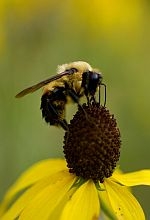 (Host) So far, Vermont’s honeybees have escaped Colony Collapse Disorder, which has led to the disappearance of hives in other parts of the country.
(Host) So far, Vermont’s honeybees have escaped Colony Collapse Disorder, which has led to the disappearance of hives in other parts of the country.
But the state’s bumblebee population hasn’t fared as well.
Leif Richardson is an ecologist with the Department of Fish and Wildlife.
Richardson says bumblebees used commercially to pollinate greenhouse crops have infected native bees with a European parasite.
Out of a total of 20 bumblebee species in Vermont, two have disappeared because of the parasite.
(Richardson) "If you watch one of these greenhouses, the bees are coming and going quite a bit and they’re foraging in the fields around the greenhouse for pollen and nectar and they’re bringing that back inside the greenhouse to their colony. When they’re outside foraging on the flowers, they are leaving the intestinal parasite, which is in their saliva, on their mouth parts. They leave it behind on a flower and a wild bee picks it up."
(Host) Richardson says there is some good news: another species of Vermont bumblebee that had been affected by the parasite appears to have rebounded.
He says greater regulation of the industry that produces bumblebees for pollination would help control the spread of diseases and parasites.
Richardson says two more species of bumblebees are also in decline in Vermont – although the reasons remain unclear.
(Richardson) "The reasons that have been cited include pesticides, land use changes, changes to agriculture in a broad sense and development, generally; development of fallow lands and borders and hedgerows and all of that into carefully manicured developments where we live and work and so on."
(Host) Richardson says bumblebees forage from many kinds of plants, and property owners can help them by planting native flowering plants and non-native species like clover and vetch.